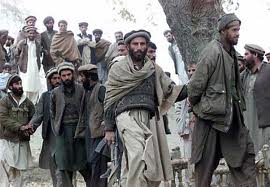Al Qaeda Makes Afghan Comeback
 The Wall Street Journal reports:
The Wall Street Journal reports:
In late September, U.S. fighter jets streaked over the cedar-studded slopes of Korengal, the so-called Valley of Death, to strike a target that hadn't been seen for years in Afghanistan: an al Qaeda training camp.
Among the dozens of Arabs killed that day, the U.S.-led coalition said, were two senior al Qaeda members, one Saudi and the other Kuwaiti. Another casualty of the bombing, according to Saudi media and jihadi websites, was one of Saudi Arabia's most wanted militants. The men had come to Afghanistan to impart their skills to a new generation of Afghan and foreign fighters.
Even though the strike was successful, the very fact that it had to be carried out represents a troubling shift in the war. Nine years after a U.S.-led invasion routed almost all of al Qaeda's surviving militants in Afghanistan, Osama bin Laden's network is gradually returning.
Over the past six to eight months, al Qaeda has begun setting up training camps, hideouts and operations bases in the remote mountains along Afghanistan's northeastern border with Pakistan, some U.S., Afghan and Taliban officials say. The stepped-up infiltration followed a U.S. pullback from large swatches of the region starting 18 months ago. The areas were deemed strategically irrelevant and left to Afghanistan's uneven security forces, and in some parts, abandoned entirely.
American commanders have argued that the U.S. military presence in the remote valleys was the main reason why locals joined the Taliban. Once American soldiers left, they predicted, the Taliban would go, too. Instead, the Taliban have stayed put, a senior U.S. military officer said, and "al Qaeda is coming back."
The militant group's effort to re-establish bases in northeastern Afghanistan is distressing for several reasons. Unlike the Taliban, which is seen as a mostly local threat, al Qaeda is actively trying to strike targets in the West. Eliminating its ability to do so from bases in Afghanistan has always been the U.S.'s primary war goal and the motive behind fighting the Taliban, which gave al Qaeda a relatively free hand to operate when it ruled the country. The return also undermines U.S. hopes that last year's troop surge would beat the Taliban badly enough to bring them to the negotiating table—and pressure them to break ties with al Qaeda. More than a year into the surge, those ties appear to be strong.
To counter the return, the coalition is making quick incursions by regular forces into infiltrated valleys—"mowing the grass," according to one U.S. general. It is also running clandestine raids by Special Operations Forces, who helped scout out the location of the Korengal strike, U.S. officials said. The twin actions offer a preview of the tactics the coalition is likely to pursue in some parts of the country as its forces hand off chunks of contested territory to Afghanistan's security forces. The process is already under way and is due to accelerate in July.
Precise numbers of al Qaeda fighters in Afghanistan at any given time are hard to come by. But officials say al Qaeda camps and gathering spots similar to the one targeted in September are now scattered across sparsely populated Kunar province, a few inaccessible parts of Nuristan province and, most worryingly to some officials, the edges of Nangarhar province. That province sits astride a major overland route from Pakistan and is home to one of Afghanistan's major cities, Jalalabad.
For the most part, al Qaeda has been viewed by Western officials as a declining force in the Afghan fight. Just six months ago, U.S. intelligence estimates indicated only one or two dozen al Qaeda fighters were present in Afghanistan at any given time. Most of the few hundred fighters it had in the region were holed up in Pakistan, hiding from Central Intelligence Agency drone strikes in mountain shelters, and beset by morale and money problems. Some fighters would occasionally cross the border to conduct training or embed with Taliban units, a pattern that had become well established over a decade of war.
Now, the U.S. pullback from northeastern Afghanistan appears to have given al Qaeda the opening it needed to re-establish itself as a force in the Afghan fight, say some U.S. and Afghan officials.

